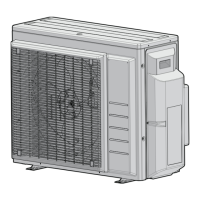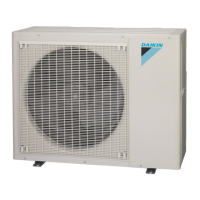
Do you have a question about the Daikin 4MXM80N2V1B9 and is the answer not in the manual?
| Model | 4MXM80N2V1B9 |
|---|---|
| Cooling Capacity | 8.0 kW |
| Heating Capacity | 9.0 kW |
| Refrigerant | R-32 |
| Type | Multi Split |
| Seasonal Energy Efficiency Ratio (SEER) | 6.1 |
| Power Supply | 220-240V, 50Hz |
Explanation of hazard symbols and warning indicators used in the manual.
General guidelines and precautions specifically for installers.
General safety advice for installers, including contacting dealers when unsure.
Specific warnings and precautions when handling R32 refrigerant.
Specific safety instructions for handling R32 and R410A refrigerants.
Critical safety instructions for electrical connections and maintenance.
Safety precautions related to installing the unit, adhering to legislation.
Precautions for connecting refrigerant piping, especially for R32 units.
Precautions and warnings during refrigerant charging.
Comprehensive safety guidelines for electrical wiring and component installation.
Safety guidelines for working with the compressor, including electrical and mechanical hazards.
Safety warnings and precautions to follow during troubleshooting.
Procedures and precautions for connecting refrigerant pipes.
Important safety and handling advice for connecting refrigerant pipes.
Procedures for checking refrigerant piping for leaks and performing vacuum drying.
Safety and procedural advice for performing refrigerant piping checks.
Steps for performing a leak test on the refrigerant piping.
Steps for performing vacuum drying on the refrigerant piping system.
Important safety and procedural precautions to follow during refrigerant charging.
Procedure for adding refrigerant to the system.
Critical safety warnings and guidelines for connecting electrical wiring.
Important safety and operational precautions before and during commissioning.
Procedures for testing the unit's functions after installation.
Steps for conducting a test run to verify system operation.
Critical safety warnings and precautions before performing maintenance or service.
Specific safety precautions and considerations for servicing the compressor.
Essential safety warnings and precautions to follow during troubleshooting.
Identifying and resolving issues based on observed symptoms.
Troubleshooting for indoor units that fall, vibrate, or make noise.
Diagnosing and fixing problems where the unit does not heat or cool properly.
Troubleshooting causes and solutions for water leaks from the unit.
Diagnosing and resolving issues related to electrical leakage.
Troubleshooting why the priority room setting is not working as expected.
Diagnosing and resolving issues where the unit fails to operate or shows signs of damage.
Interpreting LED indicators on the outdoor unit PCB for fault diagnosis.











